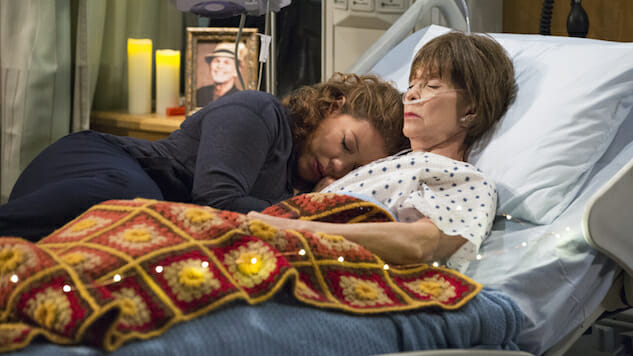Dear Netflix, Please Renew One Day at a Time
Photo: Michael Yarish/Netflix
In the season finale of One Day at a Time, Penelope Alvarez (Justina Machado), her adolescent children (Isabella Gomez and Marcel Ruiz), her landlord (Todd Grinnell), and her boss (Stephen Tobolowsky) gather at the bedside of family matriarch Lydia Riera (the irrepressible Rita Moreno), felled by a stroke on the eve of becoming an American. (Insert West Side Story wink here.) One by one, the characters speak to the comatose abuelita, and in the process Mike Royce and Gloria Calderón Kellett’s sophomore sitcom—inspired by Norman Lear’s beloved original—sounds a note we now consider old-fashioned: earnestness. Her grandson, Alex, paints her nails, as he knows she’d appreciate. Tobolowsky’s Dr. Berkowitz, Lydia’s sometime-love interest, calls her “the most alive person I know.” Penelope rages against her mother’s failings, the abandonment she felt when she joined the armed forces, then collapses in tears at the edge of the bed. Finally, Lydia herself, dressed in a gown designed to catch the angelic light, weighs this life — “the one you get” — against joining her late husband in the next one, and marks her decision with two words I hope Netflix hears.
Not yet.
As Royce has noted on Twitter more than once in recent weeks, One Day at a Time remains in limbo at the streaming giant, which is “still counting views” of the series before determining its fate. (Not coincidentally, this provides more insight into Netflix’s renewal/cancelation process than countless executive sessions and shareholder phone calls from chief content officer Ted Sarandos.) Viewership is a metric no TV network can afford to ignore, of course, though Netflix, by refusing to release such data, renders such considerations moot. The only argument to wage, then, as a way of convincing the service not to cancel One Day at a Time—not yet—is one that focuses on other measures of value, to Netflix and its subscribers. Because, once you dig beneath the surface of the laugh track and the source material, the series’ appeal is not so old-fashioned as it might seem: Its earnestness is not absent a political edge, and its classic tropes are directed at subjects one can only call modern. For a media behemoth that has produced exactly one truly great original series (BoJack Horseman), One Day at a Time is the perfect complement. It’s an innovation of sentiment in a cynical world.
Though it leaps effortlessly from topic to topic—the term “Latinx,” ethnic stereotypes, voting rights, the immigrant experience, addiction, sexual orientation, pronoun usage, I could keep going—One Day at a Time’s mettle is inextricable from its forceful belief, rare in the medium’s current climate, that the multi-camera format is an opportunity, not a hindrance. With Lear and his peerless legacy as the series’ North Star, Royce and Kellett lean into the sitcom’s intimacies, its compact spaces and familiar sets, until the fictions of the soundstage start to resemble the frankness of real life. The central sequence of Season Two’s wrenching “Hello, Penelope,” for instance, features the extraordinary Machado alone in bed, incapacitated by depression. The lighting is theatrical—a bright overhead spot that bleeds away when Lydia switches on the lamp or opens the blinds—but it’s this, and not the washed-out naturalism of so many cable dramedies, that punctuates the character’s suffering, her sense that the darkness around her is closing in. Then there’s that season finale, “Not Yet”: 35 minutes of unfiltered emotion flowing from Lydia’s loved ones, set in a single hospital room.
-

-

-

-

-

-

-

-

-

-

-

-

-

-

-

-

-

-

-

-

-

-

-

-

-

-

-

-

-

-

-

-

-

-

-

-

-

-

-

-








































